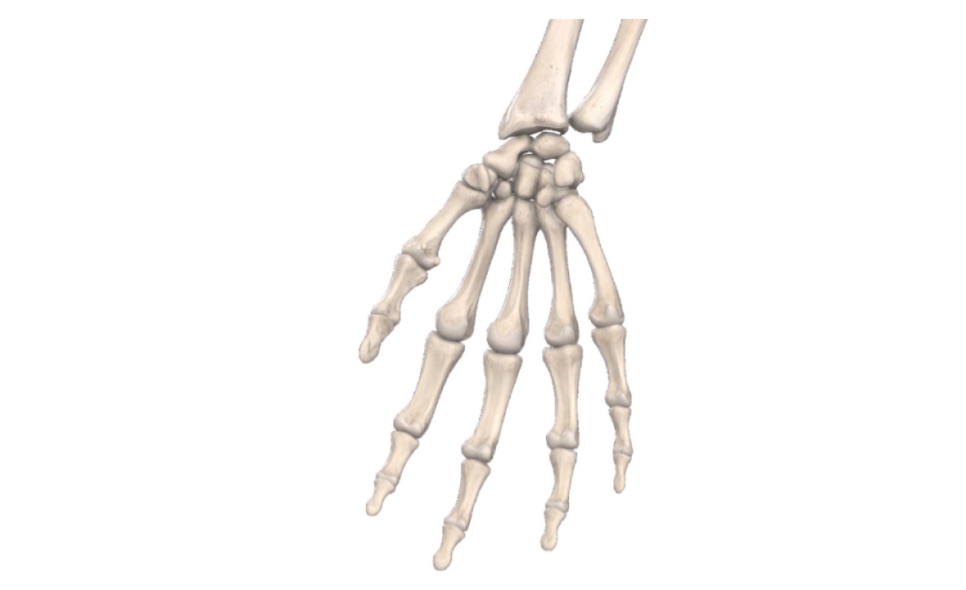
Bones of Hand & Space of Hand (Viva)
BONES OF HAND
Q.1 Name the carpal bones.
Proximal row:
Contains from lateral to medial side
- Scaphoid,
- Lunate,
- Triquetral and
- Pisiform.
Distal row:
Contains from lateral to medial side
- Trapezium,
- Trapezoid.
- Capitate and
- Hammate
Q.2 Name the structures attached to the tubercle of the scaphoid.
- Abductor pollicis brevis and
- Flexor retinaculum.
Q.3 Name the structures attached to pisiform.
- Flexor carpi ulnaris,
- Abductor digiti minimi,
- Flexor retinaculum and
- Extensor retinaculum.
Q.4 Name the site of the insertion of various muscles of the thumb.
- Flexor pollicis longus: Volar surface of base of distal phalanx
- Extensor pollicis longus: Base of distal phalanx of thumb
- Extensor pollicis brevis: Dorsal surface of base of proximal phalanx
- Abductor pollicis longus: Base of first metacarpal
- Abductor pollicis, flexor pollicis brevis and abductor pollicis brevis: Base of proximal phalanx of thumb
- Opponens pollicis: Shaft of first metacarpal
- First palmar interossei: Base of proximal phalanx.
Q.5 Name the muscles attached to the middle phalanx.
- Flexor digitorum superficialis: Inserted on sides of shaft.
- Extensor digitorum: Central slip inserted on the dorsal surface of the base.
Q.6 Name the structures attached to the base of the proximal phalanx.
Insertion of lumbricals and interossei.
- In thumb
Insertion of
– On the lateral side: Abductor pollicis brevis and flexor pollicis brevis.
– On medial side: Abductor pollicis and first palmar interosseous.
– On dorsal surface: Extensor pollicis brevis.
- In little finger,
On medial side:
Insertion of abductor digiti minimi and flexor digiti minimi.
Q.7 What are the sesamoid bones found in the upper limb?
- Pisiform: Sesamoid bone within tendon of flexor carpi ulnaris.
- Two sesamoid bones on the head of the first metacarpal bone.
- In capsule of interphalangeal joint of the thumb.
- On the ulnar side of the capsule of the metacarpophalangeal joint of little finger.
Spaces of Hand
Q.1 Name the spaces of hand.
- Palmar spaces:
– Superficial pulp spaces of the fingers
– Synovial tendon sheats of 2nd, 3rd and 4th fingers
– Ulnar bursa
– Radial bursa
– Midpalmar space
– Thenar space.
- Dorsal spaces:
– Dorsal subaponeurotic space
– Dorsal subcutaneous space.
- Forearm space of Parona
Q.2 What are the characteristic features of the pulp space of fingers?
- Front of the distal phalanx is covered with subcutaneous fat.
- Dense fibrous processes bind the skin to the periosteum and divide fat into compartments
Q.3 Why the infections of pulp space of fingers are painful?
Because it cannot expand due to fibrous processes attaching skin to the periosteum and thus little swelling causes much increase in tension.
Q.4 Why the infections of pulp space of fingers cause necrosis of distal 4/5 of terminal phalanx?
Because distal 4/5 receives its blood supply from arteries which transverse fibrous processes and increase in tension due to infection causes their occlusion and proximal 1/5 escapes necrosis because it receives its blood supply by vessels which do not traverse fibrous processes.
Q.5 Why the infections of little finger and thumb are more dangerous?
Because the synovial sheath of the little finger is continuous with ulnar bursa and that of thumb with radial bursa so, the infections of these can spread of the forearm space of Parona.
Q.6 What is the position of dorsal spaces?
The subcutaneous space lies deep to the skin and sub-aponeurotic space deep to extensor tendons on the dorsal aspect of the hand.
Q.7 What is the `forearm space of Parona' and its clinical importance?
It is space between long flexor tendons and pronator quadratus. Proximally, the upward extent is limited by the origin of flexor digitorum superficialis and inferiorly, it extends up to the upper border of flexor retinaculum. The proximal parts of the flexor tendons synovial sheath protrude into it.
Clinical importance:
It may be infected by the extension of synovial sheath infections from ulnar or radial bursa, leading to hourglass swelling.
Q.8 What is the position and clinical importance of mid-palmar and thenar space?
These are potential spaces deep to palmar aponeurosis and flexor tendons.
- Midpalmar space: Situated under inner half of hollow of palm
- Thenar space: Situated under outer half of hollow of palm
- Clinical importance: They become infected in wounds of palm and synovial sheath infections. They frequently communicate with each other, so infection can pass from one to the other.
Q.9 Why the collection of fluid is more on the dorsal surface of hand in infections of the palmar aspect of fingers?
Skin on dorsum of fingers and hand is loose, therefore fluid readily collects beneath it. But on the palm of the hand, there is little subcutaneous tissue and skin is adherent to the underlying palmar fascia.
Also read: Anatomy Question Collection
Also read: Anatomy Questions & Answers
Also read: Anatomy notes

Comments (0)